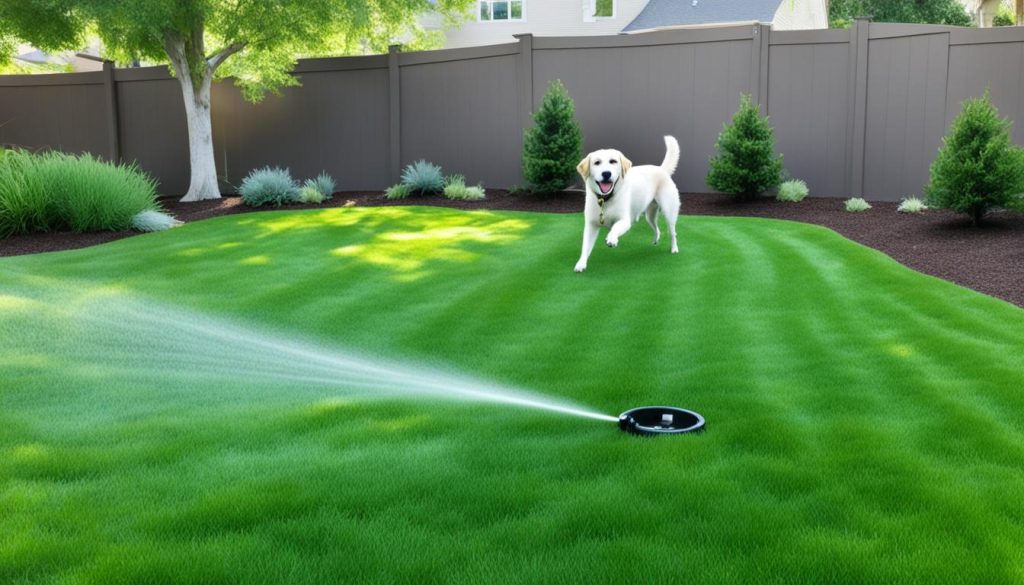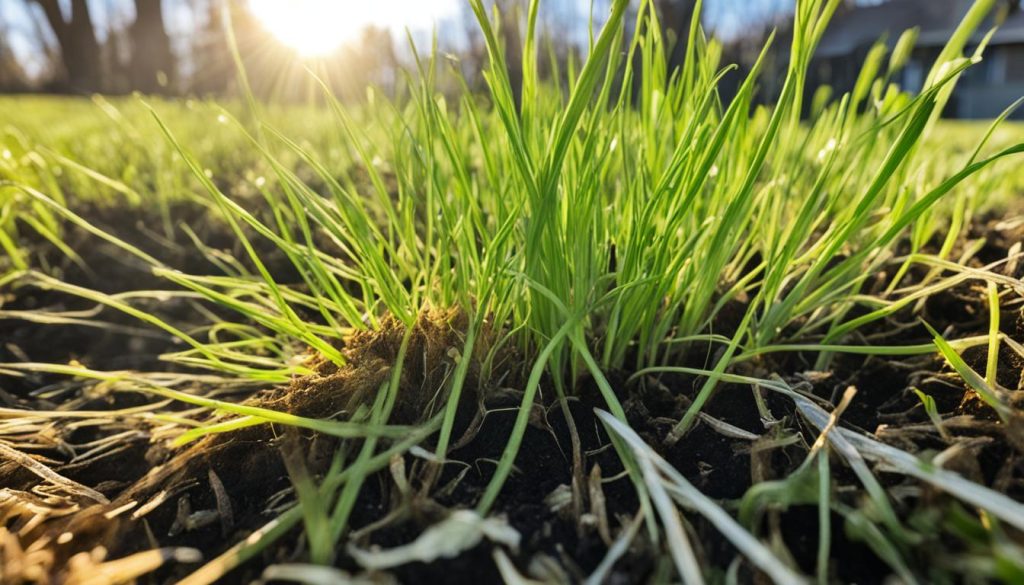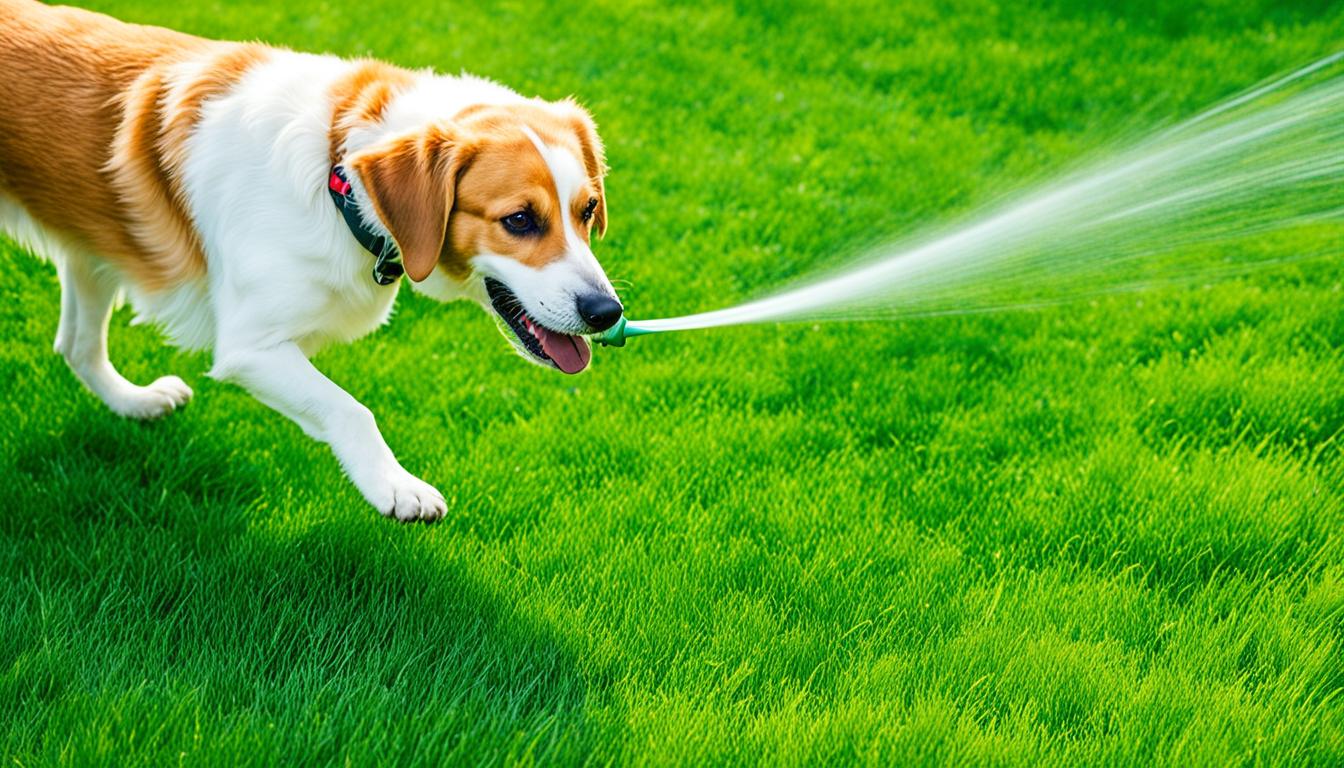Are you tired of unsightly brown spots on your once-lush lawn? The culprit could be right under your nose – or rather, your furry friend’s paws. Yes, we’re talking about those pesky dog urine spots that seem to appear out of nowhere!
But here’s the twist: Contrary to popular belief, dog urine is not inherently toxic to your grass. In fact, it contains high levels of nitrogen that can act as a fertilizer. So, what’s really causing those brown patches on your lawn? And how can you fix them?
Key Takeaways:
- Dog urine can cause brown spots on lawn due to its high nitrogen content.
- Both male and female dogs can contribute to urine damage on grass.
- Flushing the affected area with water and overseeding can help repair dog urine spots.
- Training your dog to use a designated area can minimize damage.
- With proper care and maintenance, your lawn can recover from dog urine damage.
What is a Dog Urine Patch?
Dog urine patches are areas on the lawn where dogs have urinated. Contrary to popular belief, dog urine is not inherently toxic to plants. It contains high levels of nitrogen, which can actually act as a fertilizer. However, when the urine is concentrated in a small area, it can burn the grass and result in brown patches.
To understand why dog urine can cause damage, it’s important to know about nitrogen levels and how they affect the grass. Nitrogen is a vital nutrient for plant growth, but excessive amounts can be harmful. When a dog urinates on the lawn, the concentrated nitrogen in their urine can overpower the grass’s ability to process it, resulting in an imbalance. This imbalance can lead to a chemical burn, which manifests as brown patches on the grass.
Why Does Dog Urine Cause Burning Grass and Brown Patches?
When a dog urine patch is left unattended, the nitrogen levels become too concentrated for the grass to handle effectively. As a result, the excess nitrogen can dehydrate and essentially “burn” the grass, causing it to turn brown and die. The longer the urine remains on the lawn, the more damage it can cause.
In addition to nitrogen, dog urine also contains high levels of salts and other compounds that can further contribute to grass damage. These compounds can disrupt the grass’s natural balance, hinder its ability to absorb water, and further exacerbate the burning effect.
In summary, while dog urine itself is not toxic to plants, concentrated urine in a small area can lead to burning grass and unsightly brown patches on your lawn.
Who Causes Dog Pee Damage?
Both male and female dogs can cause urine damage to the lawn. The difference lies in their squatting posture. Female dogs tend to concentrate the urine in a smaller area, resulting in more damaged spots. However, the urine from both genders has the same effect on grass.
To understand why both male and female dogs can cause damage, it’s important to examine the characteristics of their urine. Dog urine is rich in nitrogen, which can be beneficial for plants when diluted and spread evenly across the lawn. However, when the urine is concentrated in a small area, it can lead to excessive nitrogen levels and burn the grass, resulting in brown patches.
Female dogs, when they squat to urinate, tend to release the urine in a more concentrated manner within a specific location. This concentration of urine in a small area can lead to the appearance of more damaged spots on the lawn, causing frustration for pet owners.
Male dogs, on the other hand, typically urinate by lifting their leg and directing the stream of urine in a more dispersed pattern. While this may seem less damaging to the grass, the overall effect on the lawn is similar, as the concentrated nitrogen in the urine can still cause damage to the surrounding areas.
Therefore, regardless of the gender of the dog, it’s important for pet owners to be aware of the potential for dog pee damage and take appropriate measures to prevent and repair it. By understanding the causes and effects of dog urine on the lawn, you can implement strategies to keep your grass healthy and minimize the appearance of damaged spots.
| Gender of Dog | Urine Dispersal | Damage Pattern |
|---|---|---|
| Female | Concentrated in a smaller area | More damaged spots |
| Male | More dispersed pattern | Similar overall damage |
Can You Prevent Dog Pee Spots?
While it may be challenging to prevent dog urine spots entirely, there are a few steps you can take to minimize the damage. Training your dog to use a specific area of the lawn may help, but more concentrated urine can still cause burn spots. Therefore, it’s crucial to know how to repair and mitigate the effects of dog urine damage on your lawn.
Training Your Dog
One way to prevent dog pee spots on your lawn is by training your dog to use a specific area for elimination. This can be accomplished through consistent reinforcement and positive reinforcement techniques. By designating an area of the lawn for your dog to urinate, you can concentrate the damage to a particular spot, making it easier to repair and maintain the rest of the lawn.
Using Alternatives
If training your dog to use a specific area is not feasible, you can consider using alternatives to prevent dog urine spots on your lawn. There are commercially available products that claim to neutralize or dilute the urine, reducing its damaging effects on the grass. These products typically contain enzymes that break down the nitrogen in the urine, preventing it from burning the grass.
Repairing Dog Damage
Even with preventative measures, it’s essential to know how to repair dog damage caused by urine spots. This involves flushing the affected area with water to dilute the urine and minimize its burning effect on the grass. Afterward, you can add topsoil to the area to promote healthy grass growth and overseed with new grass seed. Water the repaired area diligently to ensure proper germination and establishment of the new grass.
Minimizing Concentrated Urine
Dogs with concentrated urine can cause more severe damage to your lawn. If you suspect your dog’s urine is highly concentrated, consider consulting with a veterinarian to rule out any underlying health conditions. Additionally, make sure your dog has access to plenty of fresh water to dilute their urine naturally.
Maintaining Lawn Care
Proper lawn care practices, such as regular mowing, watering, and fertilizing, can also help minimize the effects of dog urine spots. By keeping your lawn healthy and well-maintained, it will be more resilient to damage and able to recover more quickly.

| Methods | Effectiveness |
|---|---|
| Training your dog to use a specific area | Medium |
| Using urine-neutralizing products | Varies |
| Flushing with water and adding topsoil | High |
| Minimizing concentrated urine | Medium |
| Proper lawn care practices | High |
How Can You Repair Grass Damaged By Dog Urine?
If your lawn has been affected by dog urine spots, don’t worry! There are effective ways to repair the damage and restore your grass to its lush green state. Follow these steps to repair grass damaged by dog urine:
- Flushing with Water: Start by thoroughly flushing the affected area with water. This will help to dilute the urine and rinse away excess salts that can contribute to the damage.
- Removing Dry Grass: Once you’ve flushed the area, remove any dry and damaged grass. This will create a clean surface for the repair process.
- Adding Topsoil: After removing the dry grass, add a layer of topsoil to the damaged area. This will help to replenish the nutrients and create a favorable environment for new grass growth.
- Overseeding: Next, overseed the area with new grass seed. Choose a high-quality seed that is suitable for your lawn’s conditions. Spread the seed evenly across the damaged area, ensuring good coverage.
- Watering Diligently: Finally, water the newly seeded area diligently for a few weeks. Keep the soil moist but not waterlogged, as excessive moisture can hinder grass growth. Regular watering will encourage the seeds to germinate and establish healthy new grass.
By following these steps, you can repair grass damaged by dog urine and facilitate the regrowth of a vibrant, healthy lawn. Remember to be patient, as it may take some time for the new grass to fully establish. With proper care and maintenance, your lawn will soon recover from dog urine damage.
| Benefits of Repairing Grass Damaged By Dog Urine | Steps to Repair Grass Damaged By Dog Urine |
|---|---|
| 1. Restores the aesthetic appeal of your lawn | 1. Flush the affected area with water |
| 2. Promotes healthy grass growth | 2. Remove dry grass |
| 3. Prevents further damage and bare patches | 3. Add topsoil to replenish nutrients |
| 4. Enhances the overall health of your lawn | 4. Overseed the area with new grass seed |
| 5. Water the newly seeded area diligently |
Will Grass Grow Back After Dog Urine Damage?
Grass has the remarkable ability to grow back after sustaining damage from dog urine. However, it’s important to note that the recovery process may take some time. By following the right steps, you can speed up the regrowth process and restore your lawn’s green and lush appearance.
The first step in repairing dog urine damage is to flush the affected area with water. This helps to dilute the urine and rinse away any excess salts. Flushing the area with water immediately after your dog has urinated can minimize the harmful effects of concentrated urine on the grass.
Once you have flushed the area, the next step is reseeding. This involves adding new grass seed to the damaged area to promote regrowth. Choose a high-quality grass seed that is suitable for your climate and lawn type. Spread the seed evenly over the affected area, following the instructions on the seed packaging.
After reseeding, it’s essential to provide the newly seeded area with proper care and maintenance. Water the area regularly to ensure the soil remains moist but not waterlogged. This will create optimal conditions for seed germination and grass growth. It’s important to water diligently for several weeks until the new grass becomes well-established.
In addition to flushing with water and reseeding, aerating the soil in the affected area can also help stimulate grass growth. Aeration involves creating small holes in the soil to improve air circulation and nutrient absorption. You can rent an aerator or use a handheld aerating tool to perforate the soil in the damaged area.

Tips for Repairing Grass Damaged by Dog Urine
| Step | Description |
|---|---|
| Flush with water | Dilute the urine and rinse away excess salts by thoroughly flushing the affected area with water. |
| Reseed | Add new grass seed to the damaged area to promote regrowth. Choose a suitable seed for your climate and lawn type. |
| Water diligently | Provide the newly seeded area with regular watering to keep the soil moist and support seed germination and grass growth. |
| Aerate the soil | Consider aerating the soil in the affected area to improve air circulation and nutrient absorption, enhancing grass growth. |
With proper care and maintenance, your lawn will recover from dog urine damage, and you’ll once again enjoy a vibrant and healthy carpet of grass.
How to Repair Dog Holes in Your Lawn
Dogs can sometimes leave unsightly holes in your lawn due to their natural digging behavior. However, repairing these holes can be a straightforward process that restores your lawn’s appearance and prevents further damage. Follow these steps to repair dog holes in your lawn:
- Fill the holes with topsoil: Start by filling the dog holes with quality topsoil. Use a gardening shovel or your hands to evenly spread the topsoil over the holes, ensuring that it reaches the same level as the surrounding ground. This will help level the area and create a smooth surface for the next step.
- Overseed the repaired area: Once the holes are filled with topsoil, it’s time to overseed the area. Choose a grass seed variety that matches the existing lawn for a cohesive look. Sprinkle the grass seed evenly over the repaired area, following the instructions on the seed packaging for the recommended amount. Lightly rake the seed into the topsoil to ensure good seed-to-soil contact.
- Water diligently: After overseeding, water the repaired area thoroughly and consistently. This is crucial for the grass seed to germinate and establish strong roots. Keep the repaired area moist by watering it daily or as needed, depending on the weather conditions. Be careful not to overwater, as excessive moisture can hinder grass growth.
It’s important to protect the repaired area from further damage while the new grass grows. Consider fencing off the area or using temporary barriers to keep your dog away from the repaired spots. Additionally, continue training your dog to minimize future digging behavior in your lawn.
With these steps, you can effectively repair dog holes in your lawn and maintain a well-groomed, dog-friendly outdoor space.
| Steps to Repair Dog Holes in Your Lawn |
|---|
| Fill the holes with topsoil |
| Overseed the repaired area |
| Water diligently |
How to Re-Sod Other Damaged Areas in Your Lawn
If overseeding is not sufficient to repair damaged areas in your lawn, re-sodding is an effective solution. Re-sodding involves removing the damaged grass and replacing it with fresh sod. Follow the steps below to re-sod your lawn and restore its lush appearance.
- Level the damaged area with topsoil: Start by clearing any debris or dead grass from the damaged area. Then, use topsoil to level the area, ensuring that it matches the surrounding lawn. This step creates a stable foundation for the new sod to grow.
- Prepare the sod: Purchase high-quality sod from a reputable supplier. Measure the damaged area and cut the sod to fit the spot. Ensure that the sod is of the same variety as the existing grass in your lawn for a seamless blend.
- Lay the sod: Carefully place the sod on the leveled area, ensuring that it is level with the surrounding lawn. Press the sod firmly into the soil to establish good contact and prevent air pockets. If there are any cracks or gaps between the sod pieces, fill them with additional topsoil.
- Water diligently: After laying the new sod, water it thoroughly to promote proper integration with the existing grass. Watering should be done immediately after installation and continued regularly, ensuring that the sod remains moist throughout the rooting process.
Re-sodding damaged areas in your lawn offers a quick and effective way to revive the beauty of your outdoor space. By leveling with topsoil, adding fresh sod, and watering diligently, you can enjoy a rejuvenated lawn that seamlessly blends in with the rest of your yard.
Conclusion
Dog urine spots on the lawn can be a common problem for pet owners, but with the right care and maintenance, you can keep your lawn looking green and healthy. By following a few lawn care tips and implementing effective methods for repairing grass damage, you can ensure that your outdoor space remains beautiful and enjoyable for both you and your furry friend.
One of the key steps in dealing with dog urine spots is flushing the affected areas with water. This helps dilute the concentrated urine and rinse away excess salts that can cause the grass to turn brown. Additionally, adding topsoil to the damaged areas and overseeding them will promote new grass growth, filling in the spots left by the urine damage.
Regular watering is crucial for the newly seeded areas to thrive. By diligently watering the affected areas for a couple of weeks, you provide the necessary moisture for the grass seeds to germinate and establish themselves, resulting in a healthier and more vibrant lawn.
Furthermore, preventive measures such as training your dog to use designated areas for elimination can help minimize the occurrence of dog urine spots on your lawn. By providing your dog with a specific spot to relieve themselves, you can concentrate the damage in one area, making it easier to monitor and repair.
With these lawn care tips and techniques, you can effectively repair grass damage caused by dog urine spots and create a dog-friendly lawn that you can enjoy year-round. By investing time and effort in proper lawn maintenance, you can ensure that your outdoor space remains beautiful, healthy, and free from the unsightly brown patches caused by dog urine.





